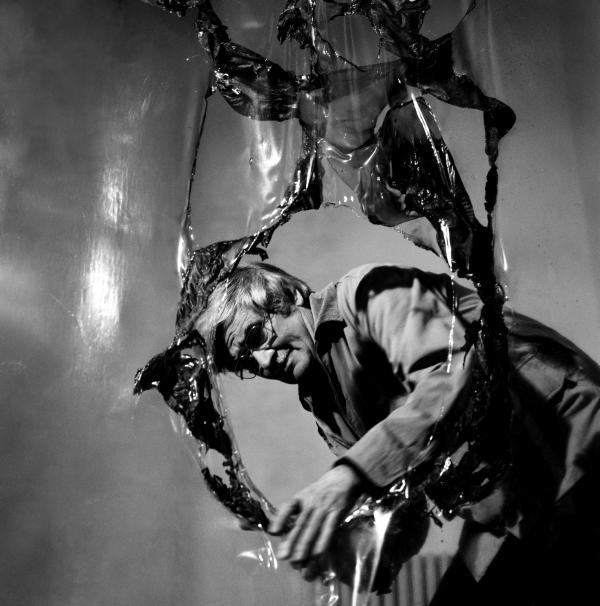In collaboration with the Fondazione Palazzo Albizzini Collezione Burri, the Fondazione Emilio e Annabianca Vedova is hosting twenty-three large prints by Aurelio Amendola in its spaces on the Zattere. The photographic selection, curated by Bruno Corà, presents visitors with a behind-the-scenes look at the artistic production of three major figures of the twentieth-century art scene: Alberto Burri, Emilio Vedova and Hermann Nitsch. Through the dialogue established with three works that complement the exhibition – Plastica M1 by Burri, Non Dove/Breccia 1988 III (op. 1 - op. 2) by Vedova, and 18b.malaktion by Nitsch – the exhibition aims to ‘highlight the different operational approaches of the three artists and their expressive attitudes’, as Alfredo Bianchini, president of the Fondazione Vedova, explains, as well as providing ‘a broad spectrum of investigation into the characteristics of a great Italian photographer’.
 The photographer’s long career began in the early 1960s. Thanks to a publication containing his photographs of the pulpit of the church of Sant’Andrea, Amendola was discovered by Marino Marini when he was only twenty-five years old, with the artist asking him to collaborate on the photographs for his anthological volume. This marked the start of a journey that led him to create a veritable Portrait Gallery featuring the great masters of the last century. His modus operandi consisted in accompanying the artists for a couple of days, finding hospitality in their studios; in this way he had the opportunity to take shots that would allow these artists to speak through their gestures and their work. Not only Burri, Vedova and Nitsch took part in this exercise, but also de Chirico, Pomodoro, Schifano, Warhol, Pistoletto, Parmeggiani and many other protagonists of the last century.
The photographer’s long career began in the early 1960s. Thanks to a publication containing his photographs of the pulpit of the church of Sant’Andrea, Amendola was discovered by Marino Marini when he was only twenty-five years old, with the artist asking him to collaborate on the photographs for his anthological volume. This marked the start of a journey that led him to create a veritable Portrait Gallery featuring the great masters of the last century. His modus operandi consisted in accompanying the artists for a couple of days, finding hospitality in their studios; in this way he had the opportunity to take shots that would allow these artists to speak through their gestures and their work. Not only Burri, Vedova and Nitsch took part in this exercise, but also de Chirico, Pomodoro, Schifano, Warhol, Pistoletto, Parmeggiani and many other protagonists of the last century.
 Amendola. Burri, Vedova, Nitsch: Azioni e gesti highlights the Pistoia-born photographer’s extraordinary ability to grasp the essence of the artists featured in his shots, granting the visitor an unprecedented opportunity: to observe these great masters in their studios as they were working. Indeed, the shots Amendola exhibits are not portraits in the most classic definition: his photography manages to capture actions and gestures, revealing the working methods used by artists in the creative act. Admiring the series created by the photographer, we can recognise the technical characteristics of each artist. Observing Burri at work, portrayed in the late 1970s in the act of creating Grande Plastica, one grasps the full force of the new expressive language he developed through the use of experimental materials. The prints portraying Vedova at the moment of executing some of his Tondi and Non Dove cycles highlight the strong emotional intensity that binds the Venetian master to painting, movement, material and sign. Finally, in Nitsch, all the tragic poetics of the cathartic emotional discharge, the theatrical space dedicated to the painter, shines through.
Amendola. Burri, Vedova, Nitsch: Azioni e gesti highlights the Pistoia-born photographer’s extraordinary ability to grasp the essence of the artists featured in his shots, granting the visitor an unprecedented opportunity: to observe these great masters in their studios as they were working. Indeed, the shots Amendola exhibits are not portraits in the most classic definition: his photography manages to capture actions and gestures, revealing the working methods used by artists in the creative act. Admiring the series created by the photographer, we can recognise the technical characteristics of each artist. Observing Burri at work, portrayed in the late 1970s in the act of creating Grande Plastica, one grasps the full force of the new expressive language he developed through the use of experimental materials. The prints portraying Vedova at the moment of executing some of his Tondi and Non Dove cycles highlight the strong emotional intensity that binds the Venetian master to painting, movement, material and sign. Finally, in Nitsch, all the tragic poetics of the cathartic emotional discharge, the theatrical space dedicated to the painter, shines through.
 In the words of the curator, ‘the collaboration between the Fondazione Burri and the Fondazione Vedova, with the operational contribution of the Museo Nitsch in Naples, has created the opportunity to set up a travelling exhibition, which began in Città di Castello and continues in Spazio Vedova, in line with the mutual acquaintance between the artists over the years in Rome, Venice and other places’.
In the words of the curator, ‘the collaboration between the Fondazione Burri and the Fondazione Vedova, with the operational contribution of the Museo Nitsch in Naples, has created the opportunity to set up a travelling exhibition, which began in Città di Castello and continues in Spazio Vedova, in line with the mutual acquaintance between the artists over the years in Rome, Venice and other places’.
